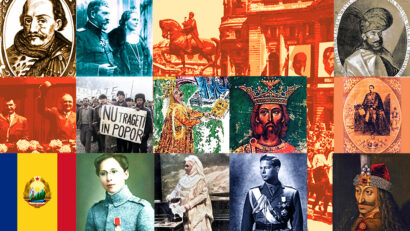Liviu Babes, a civic martyr
The story behind Liviu Babes's extreme gesture

Steliu Lambru, 18.03.2019, 13:37
The
date is March 2nd, 1989. A man who had set himself ablaze was skiing
downhill along the Bradu ski slope in Poiana Brasov, and could be seen by
hundreds of tourists. He fell near a tree, reeking with smoke and yelling. With
a final effort, the man took out a piece of cardboard from his burning coat,
reading Stop Murder. Brasov= Auschwitz. It was an act of protest against the
catastrophic condition of the Romanian society, fatefully masterminded by the
communist regime. It was also a message of solidarity with the November 1987
workers’ anti-communist strikes mounted at the Steagul Rosu and Tractorul
plants in Brasov, brutally repressed by the communist regime.
Thirty years on, it is still hard to accept Liviu
Babes’s extreme gesture. It was a cry of desperation and helplessness as an
answer to the lack of perspective regarding Romanians’ day-to-day life back
then. His sacrifice made Liviu Babes a civic martyr, much the same way other
people were during the communist regime. At this point, worth mentioning are
the names of other people from the former Soviet bloc countries who set
themselves ablaze as a form of protest. Among them, the Czechs Jan Palach,
Evžen Plocek and Jan Zajíc, the Polish Ryszard Siwiec, Lithuanian Romas
Kalanta, the Ukrainian Oleksa Hirnyk, or the Hungarian Sandor Bauer.
Liviu Babes was born on September 10, 1942 and was an
electrician supervisor with the Fabricated Parts Enterprise in Brasov. Babes was
also an amateur painter. On the back of his last painting, Babes unassumingly
wrote the German word Ende, a couple of weeks ahead of his life’s fated
momentum. What really had a strong bearing on Babes was the degradation of
Romania’s political, economic, social, cultural and moral condition in the
1980s. The workers’ strikes at the Steagul Rosu and Tractorul factories only
strengthened his resolution to do something. But what actually influenced Babes
the most in his decision was peoples’ being so passive. According to his wife,
Liviu Babes never stopped wondering about that.
Journalist and writer Mircea Brenciu is the author of The
Martyr, a volume dedicated to Liviu Babes. Brenciu wrote the book feeling it
was his duty to do it, yet writing the book was equally an honor and a
privilege for him. Mircea Brenciu referred to Babes as an intellectual, while
his extreme gesture carried a strong civic message with it. Mircea Brenciu.
Babes was an intellectual, and a
very refined one too. He had exhibitions, he sold paintings, and at the time,
he was kind of a trending fine artist in Brasov. As far as his attitude is
concerned, his is a gesture of self-sacrifice, a gesture only an intellectual
could do. Babes is part of the Romanian elite that could no longer stand the
communist atrocities. However, he was closely linked to the people, since
through his profession, he was just a supervisor with a fabricated parts
enterprise, working with ordinary people. He actually provided the connection
between the two social categories. His gesture is one of great cultural value
and he made it after careful consideration. He premeditated his act with great
lucidity and the message he conveys as he skis downhill setting himself ablaze
is indicative of a certain cultural level. The cardboard he displayed on the
slope and on which you could read Stop Murder. Braşov = Auschwitz is not the
work of an ordinary man.
In 1968, the Czech student Jan Palach set himself on
fire, in protest against the Warsaw Pact invasion of Czechoslovakia, which suppressed
the Prague Spring. Mircea Brenciu spoke about the difference between the two
gestures.
In terms of accomplishment and level of
premeditation, what Babes did was superior to Jan Palach’s gesture. What Babes
did was heroic, it was like an ancient tragedy. Jan Palach’s gesture was an
auto-da-fe (an act of faith) at a time of psychological burst, of losing
control. Babes did it with due consideration. Before setting himself on fire in
Poiana Brasov, he met with friends, was quite merry and told them how life was
starting right then. He understood that under those conditions of strict
supervision by the political police, the Securitate, he could not have done
something so dramatic if he had told anybody. He knew there were snitches everywhere
and he had to be careful in order not to raise any suspicion. Palach’s
self-immolation came in the presence of hundreds and thousands of Czechs
protesting against the invasion, while Babes did it by himself, just him
against the terrible Ceausescu dictatorship.
One of
the difficulties encountered while writing the book The Martyr, Mircea
Brenciu told us, was to find sources and documents:
From the moment he set himself on fire
and was taken by an ambulance, nobody learnt anything about him. What is
strange is that he died quite fast for someone who got burnt. People with third
degree burns do not die on that very day, they make it for a few days, and then
their kidneys fail. Babes died on the very same day, and when he was sent home
to be buried, his family was not allowed to lift the lid of the casket.
Exhumation might help, but I doubt something significant would be found. It’s
only speculation.
Babes was buried in an isolated corner of the Brasov
County Cemetery, under strict supervision by the political police. 12 hours
after the event, the ‘Free Europe’ radio station broadcast the news, and this
is how the free world found out about Liviu Babes, the civic martyr who died 30
years ago.




























